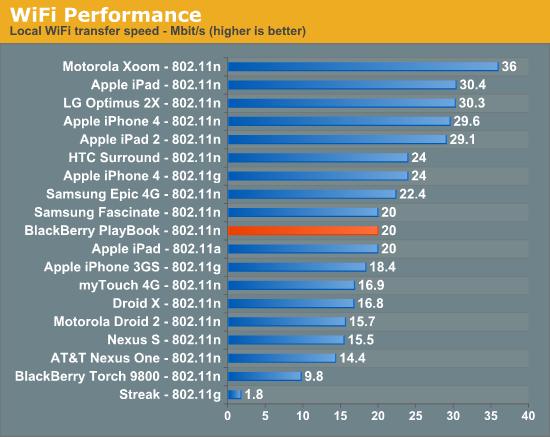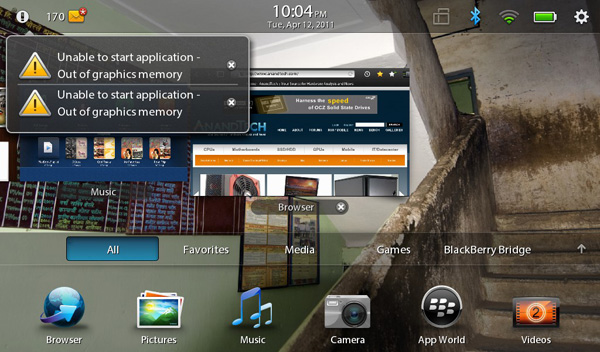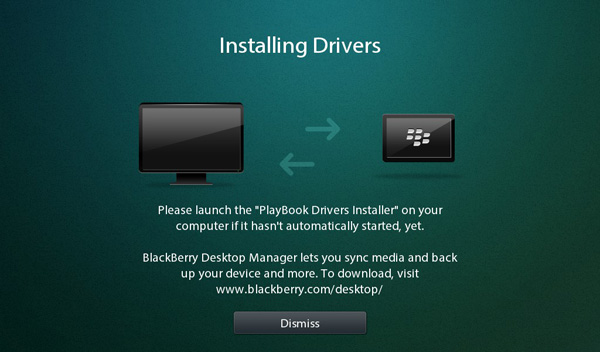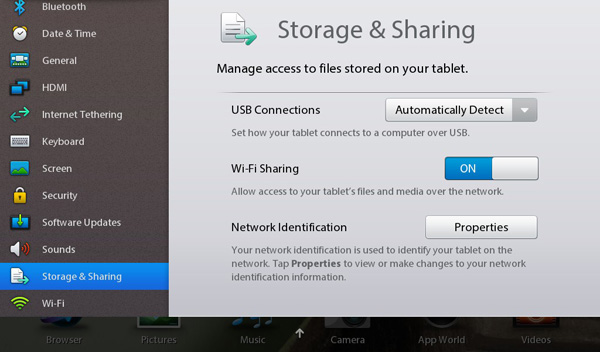The BlackBerry PlayBook Review
by Anand Lal Shimpi on April 13, 2011 9:00 PM EST- Posted in
- Tablets
- Smartphones
- RIM
- BlackBerry
- PlayBook
- Mobile
Memory Limits
Despite the PlayBook having a 1GB of LP-DDR2 memory on-board, this thing can run out of memory quickly - particularly when multitasking with BlackBerry Bridge apps. If you've got a web page loaded in the Bridge Browser, you'll only be able to open a maximum of three other Bridge apps before you run out of memory. For example, I had AnandTech loaded in the Bridge Browser with Messages, Calendar and Contacts open alongside it. If I tried to open MemoPad or Tasks the apps would quit instantly. It's only after I closed the Bridge Browser that I could launch additional Bridge apps. I don't think we're actually using a full gigabyte of memory, but I do think that I'm bumping into whatever portion of memory is reserved for Bridge apps in the above scenario.
Open up enough non-Bridge apps and you'll quickly run out of graphics memory. If you're lucky, you'll even get a nice error or two from the OS:
The biggest GPU memory hog appears to be the browser, particularly with a full web page loaded. RIM appears to keep the entire web page in memory rather than do the old take a picture of the app and display it as a thumbnail trick. As a result having a loaded web page in the browser, even if it's just in the background, eats into your limited available GPU memory. Just as there's performance tuning that has to be done on the PlayBook, there's also a lot of memory usage tuning that must be done as well.
WiFi Sharing
The big joke about the iPad is that despite being Apple's premier "post PC era" device, you start out using it by plugging it into your PC. Har har. The PlayBook is a bit more advanced.
Out of the box the PlayBook is fully functional with two methods of getting data on/off your device. There's the somewhat traditional way, using a USB cable. RIM ships the PlayBook with both Windows and OS X driver support by default. Connect it via USB to your Mac or PC and it'll appear as a removable storage device. RIM was clever enough to have the initial partition that's mounted autorun an executable, prompting you to install the BlackBerry Device Manager.
Once installed, the PlayBook will appear as a shared drive on your computer. You can copy to/from it the same way you would any other network share. The PlayBook exposes three shares that you can access: certs, print and media. Media is where pretty much everything is stored - documents, downloads, photos, videos, everything. You can copy files to/from this share without issue, and it works from both a PC or a Mac.
If you want an even more traditional sync experience, there's also the BlackBerry Desktop Software - also available for PCs and Macs. Unfortunately the current version of the BlackBerry Desktop Software doesn't support the PlayBook so I couldn't thoroughly test it.
You may wonder why the PlayBook appears as a network share rather than a traditionally mounted USB device. For starters, it lets you get around Apple's whole eject-to-remove silliness. Pull a USB mass storage device without first ejecting it under OS X and you'll get a stern warning about potential data loss from your Mac. Network shares don't suffer the same fate. Unplug the PlayBook whenever you want and your Mac won't complain.
The bigger reason for RIM going the network share route is because the PlayBook supports access to its shared volumes over WiFi as well as USB. Flip a switch in the Sharing settings page, supply an optional password and you've got the same full access to the PlayBook's NAND.
The PlayBook doesn't even have to be awake for WiFi sharing to work, it implements some form of wake on LAN. With the PlayBook in standby, hit it over the network and after a short wakeup period (~5 seconds) you'll have full access to the device. The only requirement is that your PlayBook is connected to the same network as whatever device you're trying to access it from.
When it works, WiFi sharing is great. I only have two complaints: speed over WiFi is atrocious and I can't always get WiFi sharing to work, although the latest update seemed to reduce the number of issues I've had.
Pretty much no smartphone or tablet we've tested is particularly speedy over WiFi. Even the Motorola Xoom, at the top of our performance chart, manages a meager 36Mbps. Part of this has to do with the fact that all of these devices are power rather than performance optimized and part of it has to do with NAND performance limitations. The PlayBook is even more disappointing in this regard:

The fastest I could ever write to the PlayBook over 802.11n (~5 feet away from the access point) was at 20Mbps. Typical speeds were closer to 16Mbps however. RIM tells me that there's still a lot of performance tuning that has to be done within the OS and WiFi stack. It expects the PlayBook's WiFi performance to improve, however today it is a known issue. Poor WiFi performance is more frustrating on the PlayBook because of how useful WiFi sharing is.
The PlayBook is pretty hands off when it comes to letting you use the device while you're copying data to it. I tried copying a folder full of photos over to the PlayBook while browsing the same folder on the device, unfortunately in one instance this did cause the photos app to crash. On the bright side, the crash was pretty graceful - there was no error, just an app exit. Relaunching the app worked perfectly afterwards.
I have run into situations where I simply couldn't connect to the PlayBook over WiFi. If the connection failed after two attempts, I usually had to toggle WiFi sharing on/off on the device before it'd start working. With the latest software update I received just over 24 hours ago I've run into this problem a lot less frequently. We'll see if it continues to behave well.
I am impressed with RIM's cross platform support (at least from a Mac/Windows perspective) as well as its embracing of WiFi sharing. I personally would rather just copy data over to my tablet like I would any other computer, having to go through a separate sync app should be optional.













77 Comments
View All Comments
Andrew911tt - Thursday, April 14, 2011 - link
You have the Xoom at a price of $799 but you can get the 32 GB wifi version for $599http://www.amazon.com/MOTOROLA-XOOM-Android-Tablet...
MTN Ranger - Thursday, April 14, 2011 - link
Excuse my off topic question.Anand, I notice you use Lafayette Village in your videos a lot. Do you live/work near there? We enjoy having drinks at the Village Grill and my wife loves the Upper Crust Bakery. I have taken photos there and think the architecture is great.
Anand Lal Shimpi - Thursday, April 14, 2011 - link
I'm not too far from there. It's the most interesting thing that I can photograph quickly outside of my dogs playing :)Take care,
Anand
jensend - Thursday, April 14, 2011 - link
I'm serious- this is probably the best commercial OS out there. Of course, these days most people judge an OS mostly by its included applications and the collection of software written for it, which doesn't look so good for QNX, but as far as the actual OS is concerned QNX is extremely well designed.baba264 - Friday, April 15, 2011 - link
I would tend to agree.I was very impressed upon reading all the nice features that this OS has and that are still lacking in mainstream PC OS.
The the tight kernel, the sandboxing, the thread management, the corruption protection all of it sounded real nice. Of course since it wasn't the focus of the article, many question remain, especially performance wise, still it sounded like an impressive work.
vision33r - Friday, April 15, 2011 - link
Because people are used to the iPhone / iPad and App Store being the standard.QNX is a good OS, it is tight and lean. There won't be a fragmentation problem like Android has.
The only problem is that RIM will restrict the device's functionality so that it cannot replace a Blackberry device and risk losing lucrative smartphone sales.
B3an - Friday, April 15, 2011 - link
"You can't really hover to expose controls with a touchscreen so what you end up doing is a lot of quick tapping to try and bring up controls, change the setting you want and get back to playing the video. It's frustrating and doesn't work all of the time. None of this is RIM's fault, but now that tablets are at the point where they can start to behave like notebook/desktops web developers will have to rethink the way they build websites. "I'm a web designer and specialise in interactive websites and apps, but touch screens have the ability to hold this area back and make it less elegant/messy for other devices with no touch.
The problem is not with web sites designed for non-touch devices but the need for a touch device to support hover in some way. For instance this could be done if a touch screen could detect a finger hovering over an area of the screen within say half an inch of the screen surface. That could work well if done right.
As sites get more interactive and advanced hover controls in the UI make more and more sense. because of interface complexity rises and the need for more buttons and stuff all over the place.
The thing with Flash is that being as it's far more capable than HTML5 for interaction (and with pretty much anything else too) is that it's Flash that is more likely to use hover controls in some form. But some HTML5 things are stating to use it, like the default skinned Chrome HTML5 video player for instance. Hover just makes perfect sense for certain things and touch screens need to fix this, not us web designers.
ElementFire - Friday, April 15, 2011 - link
This is a seriously well-wrought review. I'm especially glad you dedicated an entire section to Bridge, and addressed the free tethering question. As you stated, this is huge (assuming the carriers permit it), as it's the closest thing to truly unlimited browsing data plans (for no additional charge!) as we'll get now.It's a pity that Android apps need to be re-signed by RIM before they'll run. It makes sense from a security perspective (you don't want malicious apps running amok on an enterprise platform), but I'd have preferred if RIM had severely limited Android VM capability and allowed all apps to *try* to run, rather than requiring re-signing; the vast majority of Android app-developers won't have the impetus to resubmit their apps to yet another platform holder.
The last point I wanted to make was video conferencing: it's a serious letdown to only ship with point-to-point video chat (and even then, only between PlayBook owners!). If you're aiming at the enterprise, I'd expect VoIP/SIP capability and the ability to run WebEx natively. Does the PlayBook support any implementation of Java Runtime Environment?
name99 - Saturday, April 16, 2011 - link
"Pretty much no smartphone or tablet we've tested is particularly speedy over WiFi. Even the Motorola Xoom, at the top of our performance chart, manages a meager 36Mbps. Part of this has to do with the fact that all of these devices are power rather than performance optimized and part of it has to do with NAND performance limitations."Is this not simply a reflection that none of these devices use 40MHz wide channels, they all stick to 20MHz wide channels? I'm not certain about this, but given how the numbers cluster, I would bet this is the case.
(And, of course, none of these devices use multiple antennas for wifi.)
The flash has nothing to do with it. iPad flash can write sustained at a little under 20MB/s (ie 160 Mbs/s) and I imagine other tablets have similar specs.
In theory, the most power efficient way to run wifi is to do get your transmissions done as fast as possible --- in other words use 40MHz and multiple antennas and run at the maximum data rate possible. Of course this requires that the chips being used be maximally efficient in their overhead, so that essentially all power is being burned in RF transmit, not in the receivers, the decode logic and so on. It may well be that the chips supporting 40MHz, let alone MIMO, simply haven't been around for long enough to have their power usage tuned to where the 20MHz chips are.
tipoo - Sunday, April 17, 2011 - link
Most routers and laptops will default to 20MHz anyways.